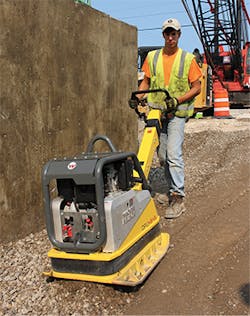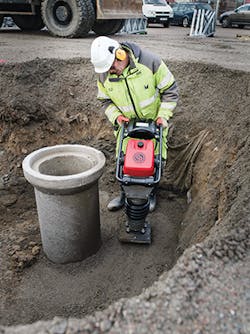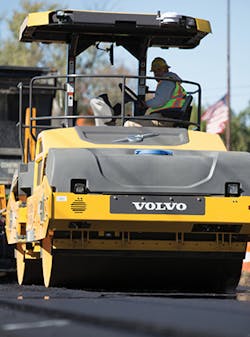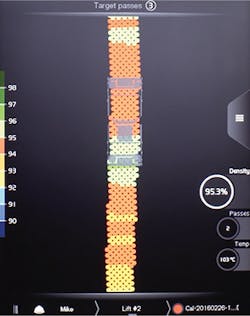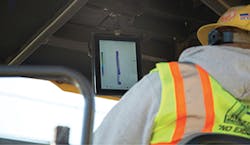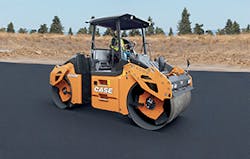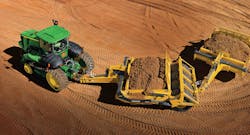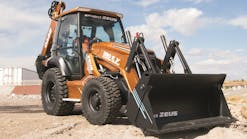Compaction is an essential part of the grading and excavating process because it is the component of the process that provides stabilization for the rest of the project, points out Ed Brenton, brand marketing manager, CASE Construction Equipment. “Without proper compaction, a job will fail in the future,” adds Brenton.
New technologies are replacing outdated methods and equipment and are helping contractors to make gains in production and efficiency. “Sending workers into larger trenches to compact material is certainly outdated in the United States,” points out Vincent Hunt, product manager, compaction and concrete, Wacker Neuson. “The industry has migrated to using remote-controlled trench rollers such as the Wacker Neuson RT series articulated trench roller. The RT can do the work of many rammers, and do it safely and effectively.”
Bryan Downing, global sales consultant for Caterpillar, points out that compaction is a process complicated by a lot of variables. “The technology available for compaction today is designed to reduce the negative influence of this variability by helping the operator produce consistent, uniform, high-quality work,” he says.
Available technology ranges from those that impact sustainable operation such as Ecomode, emission-reducing technology, or processors that conduct self-diagnostics, to efficient production “sometimes thought of as ‘smart iron,’ including Intelligent Compaction (IC)—this can also be push-button automated functions that ensure consistency or prevent poor technique,” says Downing.
He adds that there are three primary technologies now seeing use. “One is compaction indication technology. Another is GPS mapping technology, and the newest technology is machine-to-machine communication technology,” he says.
While compaction indication and mapping technologies have been in use for a long time, “machine-to-machine technology is new, and its impact has not yet been fully realized,” says Downing.
Compaction Indication technologies are those that provide the operator with real-time indications of the stiffness of the material, Downing points out. “Stiffness, rather than density, is used to define the load bearing strength of the material,” he says. “The measurements are referred to as indications because they are not absolute, due the high variability of the material.”
They can be regarded as a probability of the level of compaction of the material, says Downing, adding that they are a unit-less value often referred to as an Intelligent Compaction Measurement Value (ICMV) or CMV. “It is unit-less because it is not absolute; it is a relative value that is derived from the conditions and materials present,” he says.
Using the technologies is relatively simple, he continues. “A target value is often established by using the system on similar material proven to meet specification and using the resulting measurement as the target,” says Downing. “Another way is to calibrate the system in a test pit, watching the rate of change of the measurement with each subsequent pass until the rate of change diminishes to less than 5%—usually this amount is represented by a change of just a couple of ICMV units. The final reading is then used as the target value.”
The operator then uses the target value as a goal on uncompacted material, working the material until the values meet the target, says Downing, adding “they then have the confidence to move on to the next area.”
Many of today’s compaction indication systems available today rely on an accelerometer on the vibrating drum of the compactor, he points out. “The accelerometer measures the response of the material to being struck by the vibrating drum and converts that measurement to the ICMV,” he says. “These systems work well in granular materials and also can measure deeply into the material, as much as 1.5 meters. It should be understood that when using an accelerometer system, the measurement represents an average of this large volume of material. Because the system relies on a vibrating drum, it does not work reliably in cohesive soils. It should not be used on cohesive materials or with padfoot compactors.”
The Chicago Pneumatic MS695 Tamper
Caterpillar’s Machine Drive Power (MDP) is designed to be different from accelerometer-based measurement systems because it measures the energy the machine needs to propel through loose material and correlates that with the stiffness of the material, thus calculating an ICMV, says Downing. “The system works in all soil types with the vibratory system on or off, and on padfoot or smooth drum compactors,” he adds. “It measures about 30 to 60 centimeters deep, very close to the thickness of an average lift of material.”
Caterpillar soil compactors are available equipped with both accelerometer-based measurement and MDP systems. “This provides the widest application range, ensuring that the operator can benefit no matter the conditions present,” says Downing.
Mapping systems can take individual measurements and correlate them with the precise location they were taken, creating visual maps of the compaction work that the operator can monitor like a video game, Downing says. “The system can display high and low compaction values as different colors, allowing the operator to paint the screen one color, indicating that the material meets the compaction target value,” he says. “Mapping also allows the values to be utilized for data mining and QA/QC [quality assurance/quality control].”
Machine-to-machine is a relatively new, but potentially powerful, technology that allows an operator with a mapping system to view not only the work they are doing, but also the work of another machine working the same area, says Downing, adding that it helps assure uniform coverage of the area and reduces potential of inefficient operation or over-compaction.
For asphalt compaction applications, Caterpillar’s Auto Adjustable Compaction automates the selection of amplitude to optimize the amount of force the machine applies to the asphalt, reducing amplitude as the compaction increases, says Downing. “This takes guesswork out of the equation, allowing the machine to apply the maximum amount of force the asphalt mat can take without fracturing the aggregate or over-compacting,” he adds.
Kelly Curtis, P.E., Project Manager at Granite Construction, points out that “as we look ahead to new jobs, particularly those CALTRANS jobs requiring Intelligent Compaction, we will likely be relying more heavily on the data we’re getting from our IC system.”
Curtis and his team are using Volvo Compact Assist with Density Direct on the Volvo DD120 breakdown roller and Volvo DD110 finishing roller on a major runway reconstruction and paving job at Sacramento Airport. “Volvo’s IC system has given us an extra layer of data to back up what we’re seeing with nuclear gauge testing,” says Curtis. “Ultimately, it’s given us a comfort level to be able to scale back on our QC efforts midway into the job.”
Halfway into the paving phase of the job, Curtis says Volvo Compact Assist, along with the mix design and paving performance of his crew, contributed to the company meeting the bonus 100% of the time.
Monitoring temperatures and rolling patterns is part of the tasks of Granite Construction’s QC team. “With Volvo’s IC system, that information is now displayed in real time for the operator,” points out Curtis. “It gives our breakdown roller temperature information as it’s running right behind the paver, and gives our finishing roller pass counts to make sure they’re getting uniform coverage so there’s very little guesswork.”
The numbers the team is seeing on the density side have been very consistent as well, Curtis adds.
Mark Eckert, global product manager, Volvo Construction Equipment, notes there have been many improvements in compaction equipment over the last few decades, “all of which serve to improve mat quality and increase job site efficiency.
“For instance, impact spacing meters give operators a visual reference for speed control, helping to ensure consistent speed, and, therefore, smoothness,” he says. “Smart water systems allow operators to optimize water usage with variable flow proportional to speed, or to set the minimum flow according to job requirements.”
Another advancement in compaction equipment is the move from vibration to oscillation drums, such as Volvo’s recently introduced DD105 OSC. “Undoubtedly, the most significant technology advancement has come in the form of IC,” says Eckert. “Features such as pass mapping and temperature mapping can provide an inexperienced operator with real-time information that is easy to understand. With minimal training, the operator can make informed decisions on the fly to ensure uniform passes and compaction at peak temperatures.”
Eckert points out that pass mapping “is perhaps the feature that benefits the operator the most because it provides an easy visual reference to ensure uniform coverage without any gaps. These are benefits to pretty much any IC system on the market.”
Where the Volvo IC system—Compact Assist, the Volvo Intelligent Compaction System with Density Direct—differs from others is in its ability to provide real-time density calculations for the operator, he adds.
“Most IC systems rely on an Intelligent Compaction Measurement Value—essentially a measurement of stiffness—to correlate the value in real time to actual in-place core densities,” says Eckert. “There are several issues with ICMV values, however. In 2014, the Federal Highway Administration released a 321-page report based on a multi-year IC study, which concluded that ICMV alone cannot reliably predict core densities.”
During the IC pass mapping and temperature mapping, “the system records how many times an operator covers a certain area as well as the most recent temperature and displays it in real time,” says Eckert.
Volvo’s Compact Assist “also calculates density by utilizing a simple calibration process to ‘train’ the system for the specific material being compacted,” he adds. “Since it is calibrated every time a change is made to lift thickness or mix design, the measurement value displayed is going to be incredibly consistent.”
Advanced compaction technologies—from automatic vibration control to full machine control—help simplify operations and allow contractors to improve productivity by getting work done right the first time, notes Brenton.
“A lot of the technology going into today’s compaction equipment has to do with simplifying operation,” he points out. “Technology features like automatic vibration control make it easy to avoid surface damage from starting or stopping the machine.
“Our DV Series compactors also feature an adjustable speed control that lets operators set a maximum speed so there’s no need to worry about going too fast for the frequency of the drum,” he continues.
Basic compaction meters can tell the operator how much rebound there is on a drum, points out Brenton. “Machine control uses GPS technology to map out the number of passes and compaction stiffness readings of the total job site,” he adds. “The machine also will adjust the amplitudes and frequencies to the rebound of the drum without operator input, so the only thing the operator needs to worry about is safety and operating speed.”
CASE Construction Equipment has introduced three new products into the market.
The DV45CC Combination Vibratory Roller—a 54-inch-wide front drum with rear pneumatic tires—is designed for a smooth surface finish for small- to mid-size asphalt applications such as walkways, residential driveways, bike paths, tennis courts, and small parking lots.
An offset drum with tapered edge and high curb clearance is designed to offer precision compaction capabilities in tight spaces, notes Brenton. The tight turn radius is designed to improve compaction times. The roller also features adjustable scrapers, an automatic vibration control system, and a pressurized water system.
CASE’s DV Series is designed for a compact size and optimal maneuverability and visibility with the same control features found in heavy asphalt rollers, says Brenton. The DV45CC derives fuel efficiencies from its 40.8-hp Tier 4 Interim engine with high centrifugal forces and frequencies at lower RPMs. Standard dual amplitudes (0.01/0.21 inches) and dual frequencies (2,700/3,420 VPM) are incorporated for improved productivity. The automatic vibration control system provides automatic or operator-controlled start and stop to the drum.
Operator comfort and visibility are designed into the DV45CC through an iso-mounted operator platform to minimize vibration and reduce operator fatigue, says Brenton. A standard lateral-sliding seat provides operators with visibility to the drum edge on both sides of the machine.
The machine is designed for ground line serviceability, with all fluid ports, drains, and service checkpoints grouped on one side of the machine for simplified maintenance.
CASE Construction Equipment also recently introduced the SV208D single drum vibratory compactor compatible with smooth and padfoot drums. The compactor is designed to climb grades of up to 65%, due to a low-center-of-gravity axle-free design and a high-traction hydrostatic drive system that provides constant power to the wheels and drum with an electronic self-adjusting torque control system.
The 74.3-hp Tier 4 Final engine also delivers greater torque than previous models. The centrifugal force allows for higher lifts and deeper compaction depths completed in fewer passes and designed for increased productivity, says Brenton.
Performance on rough, uneven terrain is improved with an oscillating articulated roller joint, designed to maintain consistent drum-to-ground contact, he adds.
Brenton points out the drum is designed to reduce drift and maintain constant compaction throughout each rotation.
The SV208D is available in open and cab configurations. It is designed with a spacious, comfortable, and intuitive operator environment with an adjustable seat that swivels up to 50 degrees, providing visibility of the drum surface, he says. Rear visibility is maximized with a sloped rear deck design. The rollover protection system and roof in the open platform design can be disassembled and lowered for easier transport.
The SV208 also features an onboard diagnostics system that calculates when service is needed based on how the machine has been run. The system is designed for ground line serviceability, with access provided through an engine cover.
A Volvo Compactor with IC
CASE Construction Equipment has also introduced two double drum asphalt rollers, the DV209D and DV210D. The rollers feature a new intuitive in-steering wheel front display that gives operators real-time operating data, precision controls, and diagnostics, Brenton points out.
The vibratory asphalt rollers are designed to deliver 100% tractive effort and reliable compaction performance due to a balanced drum design and a variety of standard features that include automatic vibration control, crab steering, an oscillating articulated roller joint, and a pressurized triple-filtration water system.
A high-frequency option allows for frequencies up to 4,020 vpm (67 Hz), designed for greater control of compaction performance based on the thickness and density requirements of each lift.
A combination option also is available for both models, featuring a vibratory front roller and rear pneumatic tires designed to provide a smooth surface finish, says Brenton.
The DV209D and DV210D also feature a fully adjustable and intuitive operator environment with a steering wheel instrument cluster and digital display, he adds. “With operating weights of 21,080 and 22,930 pounds, respectively, the DV209D and DV210D are ideal for use on municipal roads, parking lots, and residential developments, as well as more large-scale paving applications such as highways, airports, and industrial areas,” says Brenton.
The new models feature a Tier 4 Final 100-hp Deutz engine that meets emissions regulations for Department of Transportation (DOT) projects. Equipped with Exhaust Gas Recirculation, Diesel Oxidation Catalyst, and Selective Catalytic Reduction after-treatment technologies, the engine works in combination with an updated cooling system and automatic idle control to reduce fuel consumption by up to 15%, compared to previous models.
Standard high centrifugal forces and dual amplitudes are designed to maximize productivity on coarse bases, hot-mix asphalt surfaces, or recycled hot-mix asphalt, while the automatic vibration control minimizes surface damage and delivers a smooth finish, says Brenton.
An articulated roller joint oscillates plus or minus six degrees to maintain reliable drum-to-ground contact and a standard crab steer design hydraulically offsets the rear drum up to 6.7 inches for precision work, he adds.
The DV209D and DV210D also feature a large water tank and a pressurized, triple-filtration water system to prevent clogs and maintain even flow to all nozzles while operating on grade. An optional compaction meter monitors material densities in real time so the operator can achieve precise densities without over-compacting, says Brenton.
GPS mapping also is available for easy mapping of compaction densities on large job sites, he says, adding with the available printer, results can be easily submitted for DOT approval and kept for record keeping.
The DV209D and DV210D also feature a “spacious, comfortable, and intuitive operator environment with an adjustable sliding/rotating seat that provides excellent visibility of the drum surfaces, edges, and spray bars,” says Brenton.
The operator station features a tilting and adjustable-height steering column and adjustable armrests with integrated control switches. A multifunctional display mounted on the steering wheel provides the operator real-time operation data, precision controls, and diagnostics.
Large swing-out doors on both sides of the machine are designed to provide easy access at ground level to all fluid ports, drains, service checkpoints, and coolers for simplified maintenance, says Brenton.
Tim Kowalski, Hamm Applications support manager, Wirtgen America, notes that the company’s technology is designed to help operators improve their work. Those technologies include oscillation, which Kowalski notes is non-destructive compaction that has been in some of the company’s machines since 1983 and is now offered in its compact line of tandem rollers.
Hamm Compaction Quality is the company’s intelligent compaction system designed to measure roller passes, temperature of the mat, and stiffness of the material being compacted.
Also offered: combination rollers, with a steel vibratory drum in the front and rubber tires in the rear. “It’s great for steep grades where you get two rollers in one,” says Kowalski.
The company provides operator controls through Easy Drive and WITOS, an equipment monitoring system to identify machine use and conditions for equipment management no matter where the machine is located, notes Kowalski.
High Frequency rollers are offered to keep up with the demands of faster paving speeds but still able to maintain proper compaction effort, he adds.
Wacker Neuson recently launched a battery-powered rammer—the AS50e—that incorporates the best of the performance characteristics of the rammer, percussion system, and ramming shoe, and adapt it to the battery-operated rammer, allowing users to experience similar compaction results to those of engine-powered units with zero emissions and less noise, notes Hunt. “The cordless rammer is a great tool for contractors to use in zero-emission applications such as indoor building rehabilitation, poorly-ventilated areas, and sound-sensitive areas such as hospitals, as well as for rental yards and environmentally-conscious builders,” he says.
Wacker Neuson’s battery-powered rammer is a zero-emissions machine driven by lithium-ion battery technology. It is designed to be convenient to operate with a quick push of a button to start, and is easy to guide along walls, says Hunt.
The guide handle is specifically designed for the rammer and results in low hand-arm vibration for the operator, he says. The AS50e weighs 154.5 pounds and hits at a percussion rate of 680 blows per minute. The battery is separate from the rammer and can be replaced without tools.
Hunt notes that operators and rental centers should derive a low cost of ownership based on the machine’s maintenance-free electric motor.
Michael Evangelista, CEO of E2 Systems—which manufactures a portable modular conveyor-material placer—notes that placing materials in a grade can have effects on yields and ease of compaction. “One traditional method of placing material is running the trucks in the grade to dump in front of a dozer or grader,” he says. “This is probably the fastest method. However, you run the risk of pumping and rutting the grade. Often, material is placed from outside the grade through placing machines, which have fairly efficient augers. They can change the gradation of the aggregate and make the compaction process more challenging.”
The portable modular conveyor-material placer “can place material quickly and transfer it to the grade in seconds only using the conveyor,” adds Evangelista. “Placing materials from outside the grade allows for a more even distribution and quicker spreading of material.”
The portable modular conveyor-material placer attaches to a wheel loader as any attachment and operates from the third valve function of the loader, he explains. “The trucks simply dump in the hopper on the belt. The material is carried to the grade in a matter of seconds. It has the capability to push trucks as it progresses.”
Weber MT offers a compaction control meter on its systems. “It is a very helpful tool to know when you’ve reached maximum compaction,” notes Angela Ellingwood, marketing operations director for Weber MT. “Over-compaction is, indeed, almost worse than under-compaction because you’re starting over again. This can cause a lot of time, and labor is the biggest expense on a job site.”
While the technology has been on the market for a dozen years, the next-generation version was recently released to include motor data management, which monitors the engine and offers information on such components as low oil levels. “In some cases, when it’s a really important issue that could potentially cause great damage to the engine, it will actually shut the machine off because you have to take care of the issue,” says Ellingwood. “It’s become an interesting tool for rental stores because a lot of the contractors, when using the equipment, don’t treat it very well and ruin it. This is helping to avoid that.”
She adds that the hydraulic hoses on Weber MT’s compactors are protected in a housing as to mitigate the problem with them often being quickly worn out. The company also designs its compactors to be able to be fixed on the job site with minimal maintenance.
“When a machine goes down, this takes time away from what you’re able to do,” points out Ellingwood. “A lot of maintenance points that are on the machine are readily accessible, so a contractor is able to change a belt without having to take the machine back to the shop. The tools are available on the machine so that you’re not looking for specific things when you need to do certain types of maintenance.”
The company has reduced the size of the flat surface area, which results in the machines moving faster while covering the same amount, she says.
Weber MT also has integrated the exciter into the baseplate as a way to avoid the challenge of loosened bolts, Ellingwood says.
Operator comfort is as important to compaction equipment as is the system’s performance, Ellingwood says. “It’s the least-liked job on the job site because it is so hard on your body,” she notes, adding that Weber MT has incorporated numerous shock mounts into its machines as well as a lower center of gravity.
The rammers are set at a tilt-forward angle as to move easier, says Ellingwood. Weber MT also manufactures reversible plates, enabling contractors to go in both directions with compaction.
Additionally, the company has released a paver roller designed for compacting slabs, pavers, natural stone, and porcelain by embedding the product in such a way that prevents shifting, cracking, and chipping, says Ellingwood, adding the company is expected to release a second, smaller version of the machine.
Weber MT also is expected to release a 70-pound rammer, which is ideal for use in trench work and laying conduit, she adds.
In contrasting current technology with some basic outdated compaction methods and equipment, Eckert notes “most successful large highway contractors are running newer equipment and practicing the latest compaction methods—they’ve had to in order to remain competitive in the face of increasingly stringent density and smoothness specifications. However, there are some cases where perhaps an outdated DOT specification has necessitated the use of a technology or method that is arguably outdated.”
Case in point: A job specification that doesn’t allow vibration on thin lifts or wear course, so a mix would have to be rolled more with a static roller or with an old steel-wheel roller. “That requires more passes, which takes more time and fuel,” he says. “This is something that has not yet been phased out with some DOTs.”
Eckert points out that in the future, changing job requirements, which increasingly have an IC specification, may lead contractors to regard any machine not equipped with IC as being outdated. “As with adoption of any technology, it will be dependent on DOTs writing these specifications into more projects,” he adds.
Downing points out that when technology such as IC is not available, the operator relies on his or her senses and experience—guesswork—or follows a method specification in the hope that the work will meet specification. “Because of the great variability of the material, this frequently results in areas that fall short of specification and/or inefficient production,” he adds.
The methods used for compaction have not changed—work is conducted on the basis of meeting a specification, Downing says. “In some cases, the process for completing the work is defined—a method specification—while in other cases the contractor is free to use whatever process necessary to meet the specification—the end-result specification,” he adds.
Compaction is fundamentally a process where a heavy roller traverses an area of material in order to reduce the voids present in the material, thus increasing the density of the material, and thereby enhancing the stability of the material under load and reducing the material’s susceptibility to the negative impact of moisture, Downing points out.
“The introduction of technology does not change this process,” he says. “What it does is it provides information to the operator that empowers them to adjust their operation to ensure that the work is consistent, uniform, and meets specification.
“The systems do not guarantee results—they simply provide additional information that helps the operator understand the relative conditions of the material. In the case where a method specification is being used, the data provided to the operator could allow them to deduce that the specification is calling for more passes than are necessary to meet the specification; follow-up field tests could verify that and perhaps reduce the number of required passes, which saves time and fuel.”
The CASE DV209D Double Drum Roller
In the case of end-result use, the technology can help optimize the number of passes and help assure uniform coverage, Downing says. “The technology can also indicate the presence of objects or materials below the surface that could have a negative impact on longevity of the road being built. Remediation can then be conducted while the ground is open and costs are relatively low. The end result is a longer-lasting, safer, higher-quality road, which is desirable to all taxpayers.”
While the fundamentals of compaction haven’t changed much over the years, today’s compaction technology makes it much easier for contractors to reach the proper compaction requirements in fewer passes, saving on labor hours as well as fuel and other operating costs, says Brenton. “Some contractors are getting ahead of the game and using machine control and other technologies, but they are still required to do the nuclear density testing on their job sites,” he points out.
Currently, the primary metrics measured include rebound detection and stiffness, says Brenton. “Measuring stiffness is said to be a better indicator than density,” he says. “If a company strictly goes off of the data from a nuclear density meter, they’re not getting load-bearing capabilities. A nuclear density test is still required, but it will be more accurate and there will be a higher chance of passing if intelligent compaction is used.”
New technology is only as effective as the ability of end users to grasp it and leverage all of its capabilities during the learning curve. “For many compaction technologies, it is as simple as flipping a switch,” says Downing. “For IC systems, it is not terribly difficult to learn to use the system. There can be some acquired skill in the ability to interpret results, but the systems themselves are comparable to using grade control.”
Compaction equipment has become easier to operate and maintain than ever before, says Brenton. “Intelligent compaction technologies give operators the ability to target exact areas on a job site that has issues, and it helps to take the operator error out of the operation,” he adds. “Advanced compaction technology allows contractors to put a newer operator on the machine and it will help them understand how to run the compactor more efficiently. While these systems are getting more intelligent, the human factor is still critical, and simplified training helps bring those operators up to speed.”
Once calibrated, the learning curve for operating a machine with Volvo Compact Assist is quite minimal, says Eckert. “The Co-Pilot interface provides numbers that an operator of any skill level should be incredibly familiar with because they’re directly tied to the job specification,” he notes. “The operator may be working to meet a target density of 96% on the project. In real time, the operator can see how close they are to achieving that target density across the entire mat.
“An IC system using ICMV values, on the other hand, may have a steeper learning curve, because the ICMV values are not necessarily easy for an inexperienced operator—or even a veteran operator for that matter—to interpret.”
ICMV is not a value that’s tied to an actual job specification, Eckert points out. “The operator might see an ICMV value of 22 on their screen. Determining how that value may or may not correlate to density of the asphalt and then using that determination to make an informed operating decision takes a great deal of expertise and experience,” he says, adding that with Volvo Compact Assist, the operator can see density percentages across the entire mat in real time.”
Techniques and principles of compaction are relatively simple and can be learned quickly, Evangelista says. “One of the most import attributes for an operator is patience,” he points out. “Running the equipment at the correct speed and frequency with proper moisture in the grade is very important to achieve your goal. You cannot be in a hurry.”
With older machines the learning curve was much greater than what it is today, notes Kowalski. “Today we have operator controls—Easy Drive—that are from one size roller to another and all the functionality, buttons and symbols are the same,” he adds. “If you run one of our rollers, you know how to run the majority of them. Everything is in the same place.”
With the recent spate of technological changes that have emerged in the compaction field, is there room for more advancement?
From the point of view of Darrell Engle, product manager, light compaction and concrete for Chicago Pneumatic Construction Equipment, “there really is not a lot of new technology going into the compaction equipment.
“Currently, when you redesign a piece of compaction, you are mainly doing cosmetic changes,” he says. “There are remote-controlled models and models with compaction indicators, but this has been available for years.
“There is work on an autonomous vibratory plate, but this is still in the infant stage and currently there is only a prototype. This will remove the operator from the equation but it will take more prep work on the area that will be compacted.”
While technology advancements are always difficult to predict and often come in waves, says Hunt, there is a trend toward the design of machines for the industry with lower total cost of ownership as well as improved ergonomics.
Volvo is continually working on technological advancements centered around automation and safety features, says Eckert. “What that may look like in the future is automation of compaction systems to create a job environment in which the operator monitors the machine and job progress, rather than actually sitting in the operator’s seat,” he says.
The machine would do the work according to job specifications and adjust settings as needed in real time, says Eckert. “This kind of automation will increase efficiency, accuracy, and safety on the job site, freeing up operators to do other work and contractors to expand their businesses,” he says, adding that the data gathered from intelligent compaction systems “could very well be vital in the validity of automation technology such as this.”
As for the future, look for electric-powered equipment to emerge, says Ellingwood.
Kowalski notes that Wirtgen America is “constantly looking at ways we can improve our products to make them easier for operators to run, and to help them do a better job with less effort or input from the operator. Changes are also due to the constantly changing mixes that we have to try to compact.”
While there are many technologies that could potentially be introduced, the real driver is acceptance, says Downing. “Contractors have hesitated to invest heavily in compaction technology—it is still often viewed as a low-skill process,” he says. “The solutions we offer elevate the role of the compactor on the job site, which adds considerable value to the contractor through efficiency and reduced risk. If they agree that there is value, contractors will invest in it.”